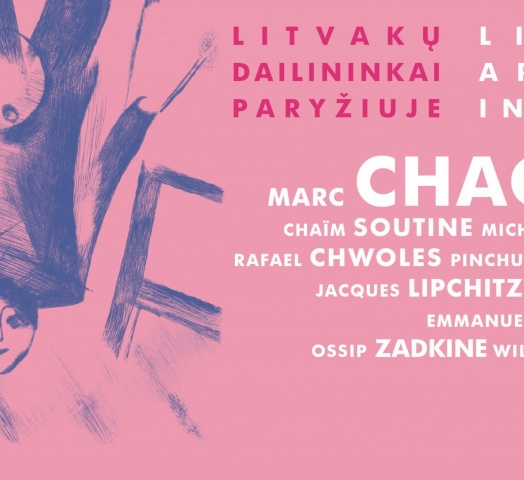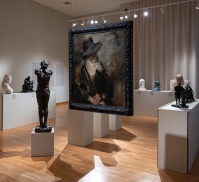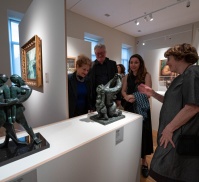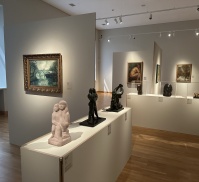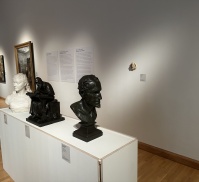Litvak Artists in Paris
On May 25th, in Vytautas Kasiulis Museum of Art a score of École de Paris artists and over a hundred of their art pieces – an exhibition Litvak Artists in Paris, the first in the Baltic countries comprehensive survey of the artwork produced by the immigrant Litvak (Lithuanian Jewish) artists in Paris was opened. Among the lenders to the exhibition of international significance are such French art institutions as the Pompidou National Centre for Art and Culture, and the Museum of the Art and History of Judaism.TARTLE lent 4 artworks to the exhibition.
As it has been pointed out by Dr Arūnas Gelūnas, Director General of the Lithuanian National Museum of Art, Litvak artists who notably contributed to the world history of art, are still waiting for a merited appraisal in Lithuania: ‘In almost every important museum around the world we are sure to find works created by the Jewish painters, sculptors or contemporary art creators originally from Lithuania or the broader territory once known as the Grand Duchy of Lithuania. I may be wrong, yet I cannot help but sense that in Lithuania, these artists, albeit earning appreciation since times long past were not held to be a fully-fledged part of Lithuania’s cultural history. One may say that the exhibition Litvak Artists in Paris is a major effort, an extraordinary artistic and historic adventure to regain this part of history.’
The exhibition will chart the stages of Litvak artists’ emigration to Paris and bring to light their ambitions and achievements, longing for the Fatherland and continuation of tradition. Early-20th-century Parisian artistic circles included quite a number of Jewish artists who arrived not only from the big European cities, but from much smaller Jewish towns and villages (shtetls) of the Russian Empire. The years 1909–1913 saw Mark Chagall, Michel Kikoïne, Jacques Lipchitz, Emmanuel Mané-Katz, Chaïm Soutine and other artists, who belonged to the same generation and had in common the several-centuries-old Litvak culture, settle in Paris. They all came seeking political, social, cultural and religious emancipation.
The youths brought up in a traditional shtetl found the first steps into the world of art quite challenging. They struggled with a strong opposition between two worlds. Confined by their religious dogmas, their own Jewish community and kin condemned the emerging artists’ desire to draw, while the world outside their shtetl ignored them because of a different culture, looks and poor knowledge of Russian, Polish and French.
This did not discourage them from pursuing the calling of art and leaving for Paris, a place of liberal artistic values and emerging new trends. There they made their names and shaped a unique phenomenon of modern art, École de Paris and a French expressionist trend, referred to also as French-Jewish expressionism. These artists did not belong to any ‘school’ in a traditional sense, as they were related not by a similarity of style, but a shared history and the same ideal. Before the outbreak of World War II, École de Paris was represented by around 60 Litvaks from Eastern Europe and over 150 Jewish artists from round the globe. The current exhibition of the Vytautas Kasiulis Art Museum brings together 21 artists of École de Paris, featuring over 130 of their works.

On May 25th, in Vytautas Kasiulis Museum of Art a score of École de Paris artists and over a hundred of their art pieces – an exhibition Litvak Artists in Paris, the first in the Baltic countries comprehensive survey of the artwork produced by the immigrant Litvak (Lithuanian Jewish) artists in Paris was opened. Among the lenders to the exhibition of international significance are such French art institutions as the Pompidou National Centre for Art and Culture, and the Museum of the Art and History of Judaism.TARTLE lent 4 artworks to the exhibition.
As it has been pointed out by Dr Arūnas Gelūnas, Director General of the Lithuanian National Museum of Art, Litvak artists who notably contributed to the world history of art, are still waiting for a merited appraisal in Lithuania: ‘In almost every important museum around the world we are sure to find works created by the Jewish painters, sculptors or contemporary art creators originally from Lithuania or the broader territory once known as the Grand Duchy of Lithuania. I may be wrong, yet I cannot help but sense that in Lithuania, these artists, albeit earning appreciation since times long past were not held to be a fully-fledged part of Lithuania’s cultural history. One may say that the exhibition Litvak Artists in Paris is a major effort, an extraordinary artistic and historic adventure to regain this part of history.’
The exhibition will chart the stages of Litvak artists’ emigration to Paris and bring to light their ambitions and achievements, longing for the Fatherland and continuation of tradition. Early-20th-century Parisian artistic circles included quite a number of Jewish artists who arrived not only from the big European cities, but from much smaller Jewish towns and villages (shtetls) of the Russian Empire. The years 1909–1913 saw Mark Chagall, Michel Kikoïne, Jacques Lipchitz, Emmanuel Mané-Katz, Chaïm Soutine and other artists, who belonged to the same generation and had in common the several-centuries-old Litvak culture, settle in Paris. They all came seeking political, social, cultural and religious emancipation.
The youths brought up in a traditional shtetl found the first steps into the world of art quite challenging. They struggled with a strong opposition between two worlds. Confined by their religious dogmas, their own Jewish community and kin condemned the emerging artists’ desire to draw, while the world outside their shtetl ignored them because of a different culture, looks and poor knowledge of Russian, Polish and French.
This did not discourage them from pursuing the calling of art and leaving for Paris, a place of liberal artistic values and emerging new trends. There they made their names and shaped a unique phenomenon of modern art, École de Paris and a French expressionist trend, referred to also as French-Jewish expressionism. These artists did not belong to any ‘school’ in a traditional sense, as they were related not by a similarity of style, but a shared history and the same ideal. Before the outbreak of World War II, École de Paris was represented by around 60 Litvaks from Eastern Europe and over 150 Jewish artists from round the globe. The current exhibition of the Vytautas Kasiulis Art Museum brings together 21 artists of École de Paris, featuring over 130 of their works.






